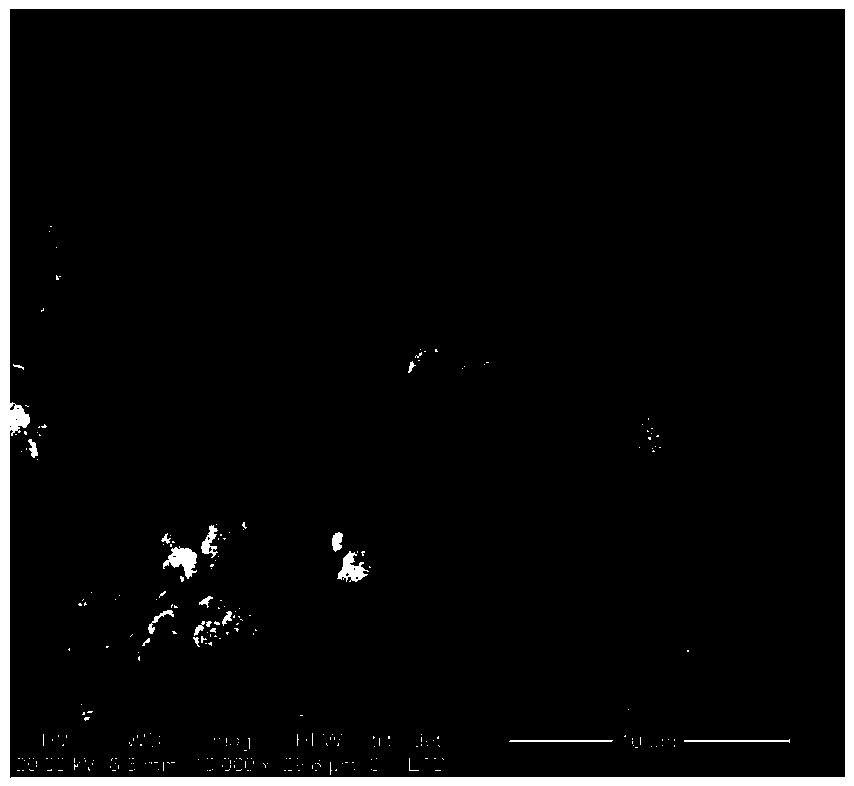Calcium-based adsorbent and preparation method thereof
A calcium-based adsorbent and adsorbent technology, applied in the field of calcium-based adsorbent and its preparation, to achieve the effects of simple operation steps, reduced erosion, convenient sampling and post-analysis treatment
- Summary
- Abstract
- Description
- Claims
- Application Information
AI Technical Summary
Problems solved by technology
Method used
Image
Examples
Embodiment 1
[0021] (1) Weigh 6g of mesoporous SiO 2 Add to 50ml deionized water to obtain solution A, weigh 8.8gCa(CH 3 COO) 2 ·H 2 O was added to 50ml of deionized solution B;
[0022] (2) Add solution B to solution A at a constant speed, and stir for 6 hours using a magnetic stirrer at room temperature, and add 1.38 g of potassium carbonate during the stirring process to obtain a colloidal solid;
[0023] (3) Place the colloidal solid in an oven and dry it at 105°C for 12 hours to make it completely dry, then place the dried colloidal solid in a muffle furnace, first at 175°C Roast for 1 hour first, then heat up to 850°C for 3 hours;
[0024] (4) Grind the calcined colloidal solid on a mortar and pass through a 24-40 mesh sieve to obtain an adsorbent with a particle size of 0.38mm-0.7mm. The SiO2 in the adsorbent 2 The molar ratio of , CaO and potassium carbonate is 10:5:1. Prepared adsorbents such as figure 1 with figure 2 shown.
[0025] pass figure 1 and figure 2 It can ...
Embodiment 2
[0027] (1) Weigh 6g of mesoporous SiO 2 Add to 50ml deionized water to obtain solution A, weigh 17.6gCa(CH 3 COO) 2 ·H 2 O was added to 50ml of deionized solution B;
[0028] (2) Add solution B to solution A at a constant speed, and stir for 6 hours using a magnetic stirrer at room temperature, and add 1.38 g of potassium carbonate during the stirring process to obtain a colloidal solid;
[0029] (3) Place the colloidal solid in an oven and dry it at 105°C for 12 hours to make it completely dry, then place the dried colloidal solid in a muffle furnace, first at 175°C Roast for 1 hour first, then heat up to 850°C for 3 hours;
[0030] (4) Grind the calcined colloidal solid on a mortar and pass through a 24-40 mesh sieve to obtain an adsorbent with a particle size of 0.38mm-0.7mm. The SiO2 in the adsorbent 2 , CaO and potassium carbonate molar ratio is 10:10:1.
Embodiment 3
[0032] (1) Weigh 6g of mesoporous SiO 2 Add to 50ml deionized water to obtain solution A, weigh 35.2gCa(CH 3 COO) 2 ·H 2 O was added to 50ml of deionized solution B;
[0033] (2) Add solution B to solution A at a constant speed, and stir for 6 hours using a magnetic stirrer at room temperature, and add 1.38 g of potassium carbonate during the stirring process to obtain a colloidal solid;
[0034](3) Place the colloidal solid in an oven and dry it at 105°C for 12 hours to make it completely dry, then place the dried colloidal solid in a muffle furnace, first at 175°C Roast for 1 hour first, then heat up to 850°C for 3 hours;
[0035] (4) Grind the calcined colloidal solid on a mortar and pass through a 24-40 mesh sieve to obtain an adsorbent with a particle size of 0.38mm-0.7mm. The SiO2 in the adsorbent 2 The molar ratio of , CaO and potassium carbonate is 10:20:1.
PUM
| Property | Measurement | Unit |
|---|---|---|
| particle diameter | aaaaa | aaaaa |
Abstract
Description
Claims
Application Information
 Login to View More
Login to View More - R&D
- Intellectual Property
- Life Sciences
- Materials
- Tech Scout
- Unparalleled Data Quality
- Higher Quality Content
- 60% Fewer Hallucinations
Browse by: Latest US Patents, China's latest patents, Technical Efficacy Thesaurus, Application Domain, Technology Topic, Popular Technical Reports.
© 2025 PatSnap. All rights reserved.Legal|Privacy policy|Modern Slavery Act Transparency Statement|Sitemap|About US| Contact US: help@patsnap.com



